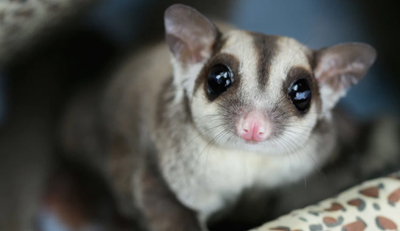Sugar Gliders
The Animal Rescue League adopts sugar gliders to be family pets. Under no circumstances should sugar gliders be used for food for other animals; for experimentation or laboratory work; or for any other use other than as a family pet. The ARL strictly enforces this policy under the terms of the adoption contract.

About Sugar Gliders
Sugar gliders are native to Australia, Tasmania, Indonesia and Papua-New Guinea. Their descriptive name comes from their love of sweet foods and a membrane between their front and rear legs that allows them to glide. Sugar gliders are marsupials which means that they raise their young in a pouch on the mother’s belly. They are small mammals and adults weigh between 4 and 5 ounces. Gliders are also nocturnal and are therefore more active at night.
The tail of the sugar glider is used for stability and balance. During gliding it acts as a rudder to control the direction of flight. A membrane of skin reaches from the wrist to the ankle and it is this membrane that gives them the ability to glide.
Sugar Gliders as Pets
Sugar gliders recognize the people that handle them and express affection and displeasure. They are social animals and do better in pairs. Sugar gliders can be very vocal and loud and bark much like a small dog.
Sugar gliders can live up to 15 years in captivity. They do need fresh fruit daily and a reasonably larger cage is necessary for their home. Although they do require some work, sugar gliders can make fun, enjoyable, and loving pets.
Diet
Your sugar glider’s diet should contain a variety of fresh fruit and vegetables and a leadbeaters formula. Gliders tend to prefer fruits and vegetables that have a sweet taste. Gliders should not be fed raw sugar, sugar substitutes or candy and never give your glider chocolate. If possible, all fruits and vegetables fed to your glider should be fresh and not canned. Food should be offered in a metal or ceramic bowl.
Leadbeaters
First developed at the Turonga Zoo in Australia the Leadbeaters formula is a staple food that is meant to be a substitute for the eucalyptus gum and acacia sap that they would eat in the wild. There are many different recipes available but the main ingredients will be honey, a good protein source and calcium/mineral supplements. Formula can be frozen to increase shelf life.
Ingredients
- 1 tsp Herptivite multivitamin supplement
- 1 ¼ tsp Rep-Cal calcium supplement
- ¼ Cup of wheat germ ½ Cup of high protein baby cereal
- ½ Cup of honey
- 2 hardboiled eggs
- 8 ounces of apple juice (no sugar added)
Fruits and Vegetables
See produce chart
Treats
Sugar Gliders love live insects. Crickets, mealworms, and earthworms are easily attainable insects. Don’t feed your glider insects that have been collected outside where they may have been contaminated with pesticides. Although great sources of protein, insects should only be used as treats due to their high fat content.
Water
Even though sugar gliders drink very little and get most of their water from food, fresh water should always be available for your pet. A stoppered water bottle is a great way to keep water available. Glass is preferred over plastic.
Cage & Habitat
You want your sugar glider to be happy and healthy so you should provide him with the best possible home. A great home is safe, secure, and has plenty of room to eat, sleep, and exercise.
Cage
Sugar gliders need room to climb so the cage should be as large as possible. For one glider the cage should be at least 20″ x 20″ x 30″. Since sugar gliders like to climb and prefer their food to be placed high up, a tall cage is best. With your pet’s home, bigger is always better, so go with the largest cage possible. The cage should use wire mesh or metal bars. Tall bird cages often make excellent homes.
The cage needs to be in an area that is away from human traffic during the day so your pet can sleep. The cage should be in an area that gets enough light to distinguish between night and day, but avoid direct sunlight.
Nesting Box
Being nocturnal, your sugar glider will need a nesting box to sleep in during the day. The nesting box can be a cloth pouch with a slit in front and attached to the side of the cage, a wooden birdhouse, or even a plastic hamster house. Fleece pouches are the best as gliders tend to prefer soft things.
Bedding & Substrate
Towels or newspaper are recommended for bedding. Wood shavings such as pine or aspen release toxic oils that can damage the respiratory system as well as the kidney and liver.
Food & Water
Heavy flat bottom dishes or dishes that attach to the sides of the cage are best for food and water. Sugar gliders like to eat up high so containers that attach to the side of the cage often work best. A stoppered water bottle that attaches to the cage is an excellent choice for water.
Decor
Sugar Gliders love to climb, so climbing branches should be provided in the cage area. Make sure you use non-toxic wood. When your pet strips the bark on the branches or the branches become soiled replace them with fresh branches. Fleece or cloth vines are also good choices for climbing surfaces.
Toys
Sugar Gliders like to play and will enjoy bird toys, ladders, chew toys, tunnels, and bells. Solid exercise wheels and run about balls can also be exciting toys for your pet sugar glider.
Health & Illness
Sugar Gliders that have been fed a proper diet, have a good home, and receive all the attention they need are healthy and happy pets. But even with proper care, sometimes illness or injury can occur. Some of the more common health concerns are listed below.
Calcium Deficiency
Symptoms of calcium deficiency are lameness, paralysis, and difficulty moving. To prevent calcium deficiency, feed your glider calcium rich foods and provide a calcium supplement.
Constipation
Sugar Gliders may become constipated if not fed enough roughage in their diet. Symptoms are a hard distended stomach, difficulty defecating, and hard dry stool.
Diarrhea
Diarrhea can be from eating too much citrus fruit, stress, or other causes. Your pet can quickly become dehydrated and die if the problem persists and is left untreated.
Injury
Your sugar glider may receive open wounds, torn claws, or broken bones from accidents and other unforeseen events. Veterinarian aid is advised for any severe injuries.
Obesity
Gliders fed a diet of fatty foods may become overweight. If your pet is overweight, reduce the amount of fatty foods in his diet. Sugar gliders of proper weight live happier and healthier lives.
Parasites
Parasites common to the sugar glider are ticks, mites, fleas, lice, roundworm, hookworm and tapeworm. Advice from a veterinarian is helpful in determining the correct treatment depending on the type of parasite.
Stress
Stress can be caused by a poor diet, illness, dirty cage, a small or overcrowded cage, over-handling, loneliness, boredom, excessive heat or cold, or one of many other possible reasons. Symptoms may be loss of appetite, excessive eating, excessive sleeping, or frantically circling the cage.
